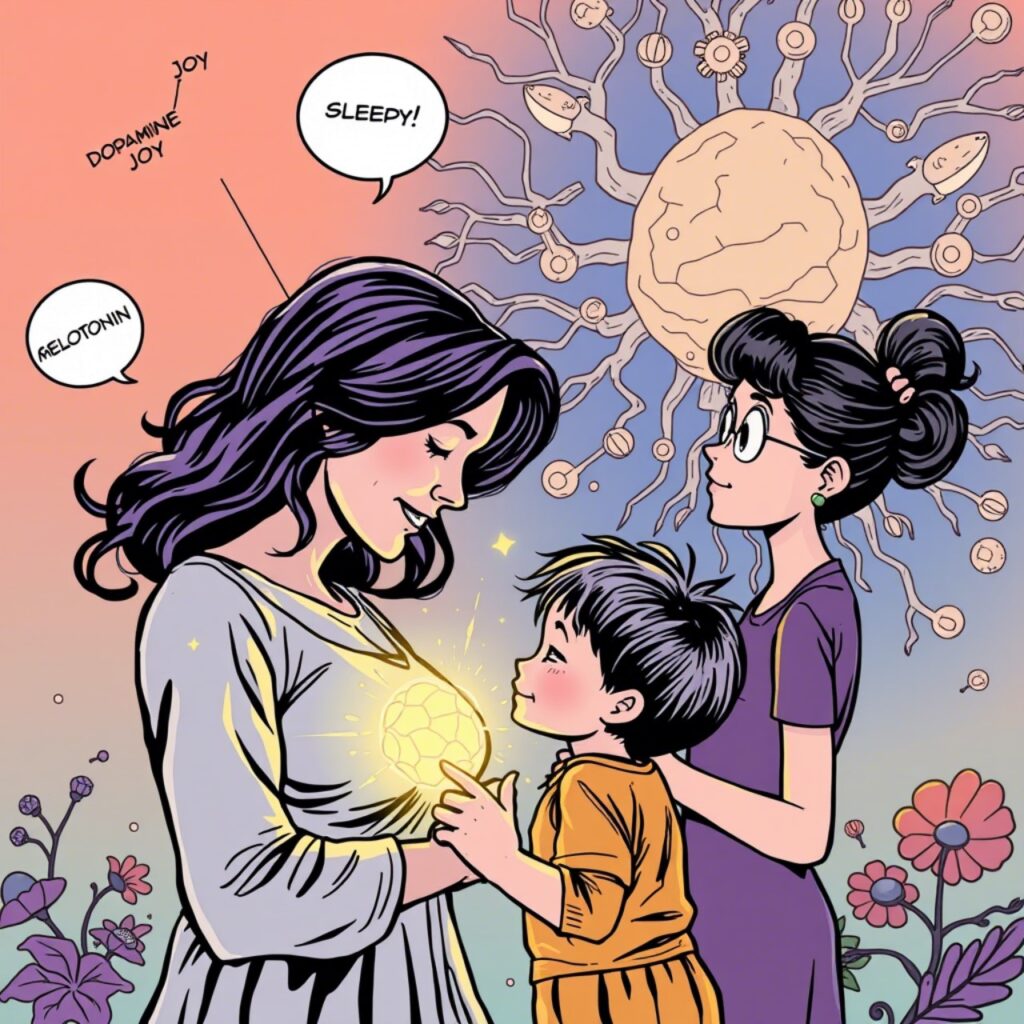The Dopamine–Serotonin–Melatonin Axis: Why Sleep, Joy, and Motivation Collapse Together

(And Why the Gut Decides Who You Become)
🎭 Three Neurochemicals, One Axis of Human Experience
This page maps a biochemical reality that explains everything from tantrums to depression, from autistic shutdowns to insomnia in kids and adults with spectrum, ADHD, anxiety, and trauma.
You’ve heard the names:
- Dopamine ➝ Drive. Motivation. Movement. Executive function. Curiosity.
- Serotonin ➝ Contentment. Patience. Mood regulation. Gut movement. Social ease.
- Melatonin ➝ Sleep. Darkness response. Mitochondrial repair. Circadian rhythm.
But these are not separate systems.
They form an interdependent axis—one that begins in the gut, not the brain.What do a hyperactive child, a shut-down autistic toddler, and a vaccine-injured adult with chronic fatigue have in common?
Their inner defense system never got the message that the war is over.
This page traces the cellular players responsible: microglia in the brain, and mast cells in the gut and body. These immune sentinels respond to infection, stress, toxins, and even perceived danger signals from cellular debris and ATP. In trauma, spectrum conditions, and chronic inflammation, they don’t switch off.
🧠 Where They Come From
🔬 Dopamine
- Requires phenylalanine ➝ tyrosine ➝ L-DOPA ➝ dopamine.
- Requires iron, B6, folate, BH4 (a cofactor made in healthy mitochondria).
- 50%+ of peripheral dopamine made in the gut lining by certain microbes (e.g. Enterococcus, Bacillus).
- ADHD brains often show low dopamine transmission in the prefrontal cortex (Volkow et al., 2009).
🌿 Serotonin
- 90–95% made in the gut’s enterochromaffin cells, stimulated by SCFAs from butyrate-producing bacteria (like Roseburia and Faecalibacterium).
- Requires tryptophan, vitamin B6, magnesium, zinc.
- Tryptophan can also be hijacked into kynurenine ➝ inflammatory pathways (common in gut inflammation, autism, and long COVID).
- Low serotonin ➝ OCD, rigidity, panic, GI distress.
🌒 Melatonin
- Made from serotonin, primarily at night.
- Synthesis depends on darkness, methylation, and mitochondrial energy availability.
- Requires phenylalanine ➝ tyrosine ➝ L-DOPA ➝ dopamine.
💥 When the Axis Fails
Collapse in Autism:
- Tryptophan ➝ pulled into kynurenine instead of serotonin ➝ immune alert stays high.
- Melatonin synthesis blocked ➝ chronic insomnia ➝ no cellular repair.
- Dopamine signaling altered ➝ restricted behaviors, low exploration, reward-seeking stims.
- No microbiome to reset the loop.
Collapse in ADHD:
- Dopamine synthesis/binding impaired ➝ poor focus, impulsivity, restlessness.
- Serotonin deficit ➝ emotional reactivity, anxiety, social dysregulation.
- Melatonin drop ➝ trouble falling/staying asleep ➝ worsens behavior next day.
Collapse in Chronic Inflammation:
- Gut damage ➝ tryptophan never gets to the brain.
- Mitochondria overloaded ➝ can’t methylate serotonin ➝ melatonin tank stays empty.
- Constant immune triggers blunt dopamine ➝ apathy, depression, flatness.
🦠 Who Makes These Molecules? Your Microbes.
This is where the Love Bacteria return:
- Roseburia and Faecalibacterium ➝ SCFAs that drive serotonin synthesis.
- Akkermansia ➝ regulates mucosal access, keeps inflammation low so tryptophan can flow.
- Without them?
➝ The axis fails.
➝ The body can’t feel reward, peace, or rest.
These aren’t “mental health” disorders.
They are signal transduction collapses caused by terrain failure.- Tryptophan ➝ pulled into kynurenine instead of serotonin ➝ immune alert stays high.
📚 Evidence Base
- O’Mahony et al., 2015 (Front Neurosci): Gut microbes modulate tryptophan metabolism and serotonin synthesis.
- Hsiao et al., 2013 (Cell): Microbiota modulate behavioral and physiological abnormalities in a mouse model of autism.
- Kau et al., 2011: SCFAs influence neurodevelopment and immune regulation.
- Kang et al., 2013: Children with ASD have altered tryptophan metabolism and microbial loss of serotonin-inducing bacteria.
- Lembo et al., 2010: Melatonin levels correlate with GI function and mood in IBS patients.
Bested et al., 2013: Chronic fatigue, depression, and cognitive dysfunction often correlate with mitochondrial stress + low melatonin.
- O’Mahony et al., 2015 (Front Neurosci): Gut microbes modulate tryptophan metabolism and serotonin synthesis.
🧬 The Methylation & Mitochondria Connection
All three axis chemicals require:
- Methyl donors (SAMe, folate, B12, choline).
- ATP from mitochondria to fuel synthesis and recycling.
Chronic inflammation—whether from mold, infection, glyphosate, vaccine adjuvants, or gut damage—blunts methylation and burns out mitochondria.
No fuel = no axis.💡 Why This Axis Is the First to Restore
If the child (or adult) can’t sleep, feel joy, or care about consequences, they can’t learn, connect, or heal.
Terrain-first restoration means:
- Rebuilding the microbial keystones that make precursors.
- Calming immune overactivation (see mast cell & microglia page).
- Feeding the cofactors (B6, zinc, magnesium, methyl donors).
- Resetting circadian rhythm, darkness hygiene, and mitochondrial repair.
- Making space for joy again—not as luxury, but as biological necessity.
- Methyl donors (SAMe, folate, B12, choline).
